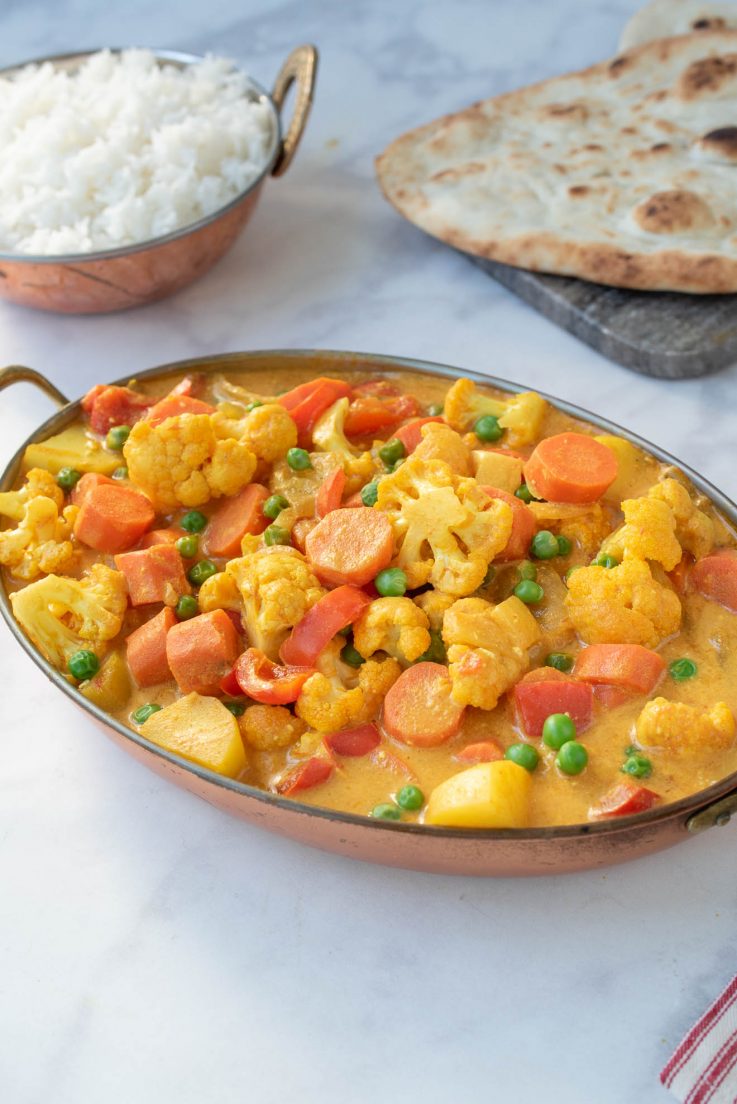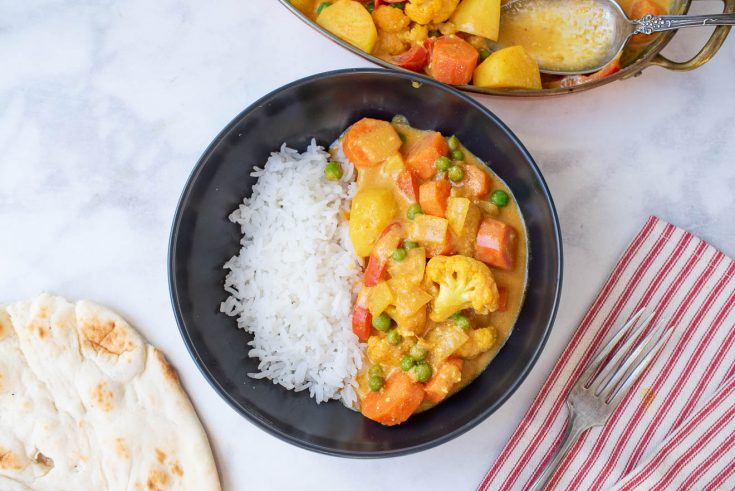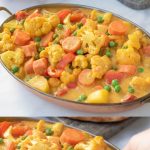Vegetable Indian Curry
Quick, easy and just happens to be healthy. This Vegetable Indian Curry is full of veggies and full of flavor. Today I’m taking you to curry school. There are many countries that make a variety of different curries, today I’m bringing you an Indian curry.

An Indian curry is made up of a blend of spices. There are many different spices in different combinations that are used to make the varieties of Indian curry that vary from mild to very spicy.
The most common spices that you will find in Indian curries are cumin, turmeric, coriander and ginger. There are others that are less-known like cardamom, fenugreek and tamarind and Kashmiri or Kashmirilal (spicy red chilli powder) just to name a few for which there are any number of ways to blend the for differing results.
Everyone knows the curry powder that you can find in the store. This is just a blend of some of the spices mentioned above but to really achieve a great curry taste, mixing your own is key.
In addition to being gluten-free, low carb/keto (minus the rice), this Vegetable Indian Curry is very low in fat and calories, plus there are health benefits. The turmeric is an anti-inflammatory and there are probiotics and protein in the Greek yogurt. Why wouldn’t you want to make this?

One of the fun things about eating Indian food is the variety of other dishes you can serve for a buffet-type feast. I have so many other recipes like Curry Vegetable Basmati Rice, Indian Tomato Chutney and most importantly Naan Bread, it is so easy to make. There are more! You can browse all my recipes here Indian Recipes.
So getting back to curry school. Adding the blend of spices is just a small part of getting the really good curry flavor. The spices themselves actually need to cook in oil to not only release their flavor, but take away the raw taste.
Using the traditional Indian method of making a garlic/ginger paste and a fresh tomato blended with tomato paste, these items are added after the spices so they can all cook together to develop the flavors. We’re flavor building.

Cooking with yogurt
Adding yogurt to hot curries can make it separate and your sauce will look like there are little white flecks all over.
Why did the yogurt separate?
This is just what happens when yogurt is heated, and why it is added after the curry is taken off the heat. It should never be boiled.

To fix the yogurt issue. I have been known in the past (because of picky eaters) to fish out all the vegetables and blend the sauce. This is a good option if you have people who may question your cooking.
If you don’t mind the way it looks, you can leave it. You can also try whisking the sauce without breaking up the vegetables.
Vegetable Indian curry

Carrots, potato, cauliflower and peas are cooked in a delicious curry sauce.
Ingredients
- 3 garlic cloves, peeled
- 1-inch (2 ½ cm) piece of fresh ginger, peeled
- 1 small jalapeño pepper, seeded and chopped
- 4 ounces (113 grams) tomatoes, chopped
- 1 tablespoon tomato paste
- 3 tablespoons vegetable oil
- 6 ounces ( 170 grams) yellow onion, chopped
- 1 red bell pepper, chopped
- 1 teaspoon ground cumin
- 1 teaspoon turmeric
- 1 tablespoon ground coriander
- 1 teaspoon ground ginger
- ½ teaspoon kashmiri/red Indian chili powder (substitute cayenne pepper)
- 1 teaspoon salt, or to taste
- 1 tablespoon maple syrup
- 1 1/2 cups (354 ml) vegetable broth
- 8 ounces (226 grams) carrots, peeled and cut into large pieces
- 6 ounces (170 grams) potato, cut into 1 inch cubes
- 8 ounces (226 grams) cauliflower florets
- 1 tablespoon corn starch
- 5 ounces (141 grams) plain Greek yogurt
- ¾ cup (88 grams) fresh or frozen peas
Instructions
- Add the garlic, ginger and jalapeño pepper to a blender with a little water. Blend to make a fine paste. Remove and set aside. To the same blender, blend the tomatoes and tomato paste. Set aside.
- To a large saucepan, braising pan or Dutch oven, add the oil over medium heat. When hot add the onion and bell pepper. Stir in the cumin, turmeric, coriander, ground ginger, Indian chili powder and salt, cook for 1 minute. Add the garlic/ginger paste, the blended tomatoes and maple syrup, mix well.
- Add the broth, carrots and potatoes, stir to combine. Cover and simmer for 5 minutes. Remove the lid, add the cauliflower and peas. Simmer for 10 more minutes with the lid removed until the potatoes and carrots are tender.
- In a small bowl mix the cornstarch and 1 teaspoon water. Stir into the curry and simmer until thickened. Remove from the heat, stir in the yogurt, a little at time until well combined. Whisking may help prevent any white flecks, which is just the yogurt reacting to the heat. It is perfectly fine to eat. You can separate the sauce from the vegetables and blend if the yogurt looks separated.
- Taste for seasoning, add more salt if needed. Serve with white rice.
Notes
Yields: 8 CUPS/4 PINTS
Nutrition Information
Yield
4Serving Size
1Amount Per Serving Calories 298Total Fat 13gSaturated Fat 1gTrans Fat 0gUnsaturated Fat 10gCholesterol 4mgSodium 752mgCarbohydrates 39gNet Carbohydrates 0gFiber 7gSugar 18gSugar Alcohols 0gProtein 11g
This nutrition calculation is provided by Nutronix that is only a guideline and not intended for any particular diet.


20 Comments on “Vegetable Indian Curry”
If I’m trying to feed 5 people what do u recommend? x2? x3? thanks!
The recipe feeds 4, but just to be on the safe side, I would double the recipe. It makes great leftovers, enjoy. 😊
Made this yesterday, excluding the yogurt and it was divine. Had some for lunch today and it was better.
I’m so happy you enjoyed the curry, it’s one of my favorites 🙂
hi, i love chicken tikka masala from the indians. how do i get it to look and taste the same at home. theres lots if recipes ive tried, but never comes close to the taka away version
thx
I have a chicken tikka masala that has been very popular for many years and has a lot of positive reviews with people even saying it tastes like their favorite restaurant. Here is the link, let me know if you have any questions and enjoy > https://culinaryginger.com/chicken-tikka-masala/
Can I add dry lentils instead of canned chick peas, and if so, do I need to adjust/add liquids?
I would not add dry lentils, cooked would be better. If you’re looking for a lentil-based curry, you may prefer my lentil dal: https://culinaryginger.com/indian-dal/
I was very excited because I love curry but I am no a fan of cumin at all 🙁 Can I just leave it out next time?
Hi Amber, you don’t taste the cumin itself because it’s mixed with all the other spices so I would think it would be fine to leave it out. Thank you for stopping by, I hope you make the dish.
I can always count on you for a brilliant curry recipe. I love that this is a vegetable one, because I am always trying to eat more vegetables. Thanks for the tip on cooking the spices in oil first, too!
What a wonderful recipe! Are you sure you are not Indian? 🙂 You know Indian recipes so well and it is just like a typical Indian dinner table. I absolutely love this recipe and can’t wait to try it.
This is perfect for fall! I love the combination of flavors and colors! Beautiful!
This is absolutely on my “to do” list. I love all the flavors, herbs and spices in here. Great array of veggies too! Pinned, YUM’d and SU’d.
This sounds fantastic, Janette! I LOVE the choice of spices and vegetables. Indian cuisine is one of my favorites so I cannot wait to try this!
This looks wonderful! I love Indian food, but have never made it at home. I think this recipe is just the reason to break that trend! Thanks for this!
Thank you Kathleen, this is a nice easy recipe to start with.
The color is simply amazing! The taste must be equally great!
What a beautiful dish this is Janette. I love the flavor of curry.
Thank you Patty, I love the simplicity of the dish and makes great leftovers.